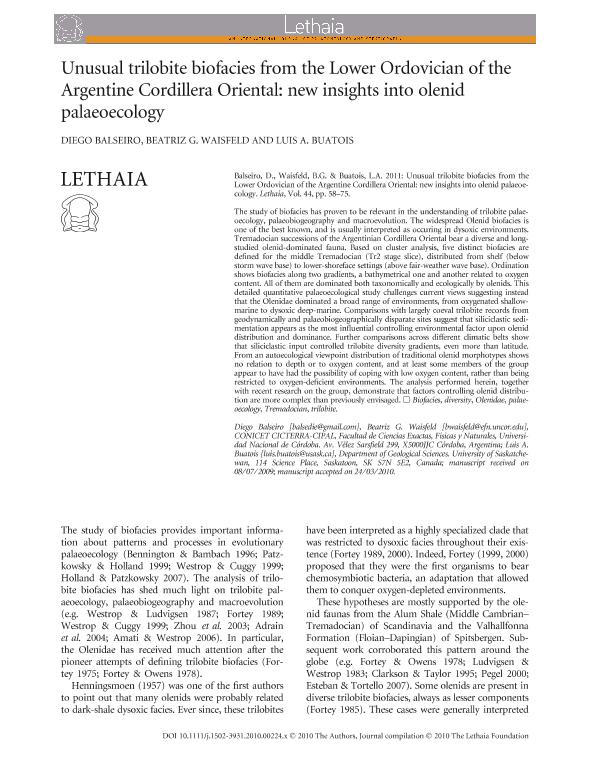Mostrar el registro sencillo del ítem
dc.contributor.author
Balseiro, Diego

dc.contributor.author
Waisfeld, Beatriz Graciela

dc.contributor.author
Buatois, Luis Alberto

dc.date.available
2018-08-03T20:50:17Z
dc.date.issued
2011-03-02
dc.identifier.citation
Balseiro, Diego; Waisfeld, Beatriz Graciela; Buatois, Luis Alberto; Unusual trilobite biofacies from the Lower Ordovician of the Argentine Cordillera Oriental: New insights into olenid palaeoecology; Wiley Blackwell Publishing, Inc; Lethaia; 44; 1; 2-3-2011; 58-75
dc.identifier.issn
0024-1164
dc.identifier.uri
http://hdl.handle.net/11336/54182
dc.description.abstract
The study of biofacies has proven to be relevant in the understanding of trilobite palaeoecology, palaeobiogeography and macroevolution. The widespread Olenid biofacies is one of the best known, and is usually interpreted as occuring in dysoxic environments. Tremadocian successions of the Argentinian Cordillera Oriental bear a diverse and long-studied olenid-dominated fauna. Based on cluster analysis, five distinct biofacies are defined for the middle Tremadocian (Tr2 stage slice), distributed from shelf (below storm wave base) to lower-shoreface settings (above fair-weather wave base). Ordination shows biofacies along two gradients, a bathymetrical one and another related to oxygen content. All of them are dominated both taxonomically and ecologically by olenids. This detailed quantitative palaeoecological study challenges current views suggesting instead that the Olenidae dominated a broad range of environments, from oxygenated shallow-marine to dysoxic deep-marine. Comparisons with largely coeval trilobite records from geodynamically and palaeobiogeographically disparate sites suggest that siliciclastic sedimentation appears as the most influential controlling environmental factor upon olenid distribution and dominance. Further comparisons across different climatic belts show that siliciclastic input controlled trilobite diversity gradients, even more than latitude. From an autoecological viewpoint distribution of traditional olenid morphotypes shows no relation to depth or to oxygen content, and at least some members of the group appear to have had the possibility of coping with low oxygen content, rather than being restricted to oxygen-deficient environments. The analysis performed herein, together with recent research on the group, demonstrate that factors controlling olenid distribution are more complex than previously envisaged. □Biofacies, diversity, Olenidae, palaeoecology, Tremadocian, trilobite.
dc.format
application/pdf
dc.language.iso
eng
dc.publisher
Wiley Blackwell Publishing, Inc

dc.rights
info:eu-repo/semantics/openAccess
dc.rights.uri
https://creativecommons.org/licenses/by-nc-sa/2.5/ar/
dc.subject
Biofacies
dc.subject
Diversity
dc.subject
Olenidae
dc.subject
Palaeoecology
dc.subject
Tremadocian
dc.subject
Trilobite
dc.subject.classification
Meteorología y Ciencias Atmosféricas

dc.subject.classification
Ciencias de la Tierra y relacionadas con el Medio Ambiente

dc.subject.classification
CIENCIAS NATURALES Y EXACTAS

dc.title
Unusual trilobite biofacies from the Lower Ordovician of the Argentine Cordillera Oriental: New insights into olenid palaeoecology
dc.type
info:eu-repo/semantics/article
dc.type
info:ar-repo/semantics/artículo
dc.type
info:eu-repo/semantics/publishedVersion
dc.date.updated
2018-08-02T14:53:01Z
dc.identifier.eissn
1502-3931
dc.journal.volume
44
dc.journal.number
1
dc.journal.pagination
58-75
dc.journal.pais
Reino Unido

dc.journal.ciudad
Londres
dc.description.fil
Fil: Balseiro, Diego. Consejo Nacional de Investigaciones Científicas y Técnicas. Centro Científico Tecnológico Conicet - Córdoba. Centro de Investigaciones en Ciencias de la Tierra. Universidad Nacional de Córdoba. Facultad de Ciencias Exactas Físicas y Naturales. Centro de Investigaciones en Ciencias de la Tierra; Argentina. Universidad Nacional de Córdoba. Facultad de Ciencias Exactas Físicas y Naturales. Centro de Investigaciones Paleobiológicas; Argentina
dc.description.fil
Fil: Waisfeld, Beatriz Graciela. Consejo Nacional de Investigaciones Científicas y Técnicas. Centro Científico Tecnológico Conicet - Córdoba. Centro de Investigaciones en Ciencias de la Tierra. Universidad Nacional de Córdoba. Facultad de Ciencias Exactas Físicas y Naturales. Centro de Investigaciones en Ciencias de la Tierra; Argentina. Universidad Nacional de Córdoba. Facultad de Ciencias Exactas Físicas y Naturales. Centro de Investigaciones Paleobiológicas; Argentina
dc.description.fil
Fil: Buatois, Luis Alberto. University of Saskatchewan; Canadá
dc.journal.title
Lethaia

dc.relation.alternativeid
info:eu-repo/semantics/altIdentifier/url/https://onlinelibrary.wiley.com/doi/abs/10.1111/j.1502-3931.2010.00224.x
dc.relation.alternativeid
info:eu-repo/semantics/altIdentifier/doi/http://dx.doi.org/10.1111/j.1502-3931.2010.00224.x
Archivos asociados
